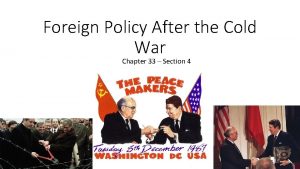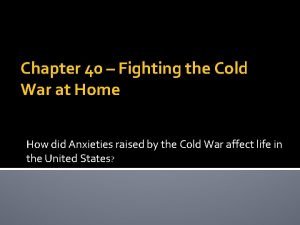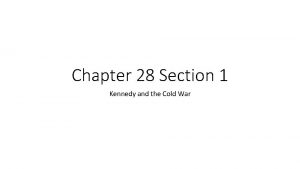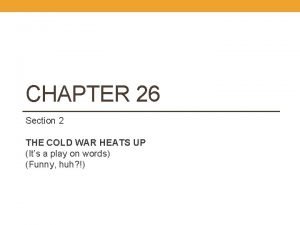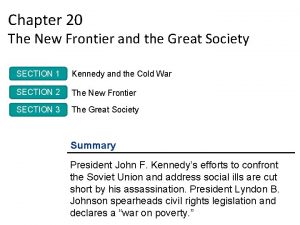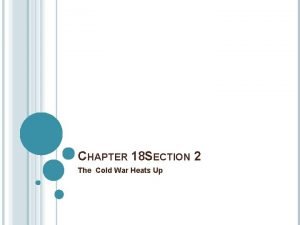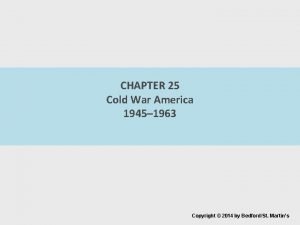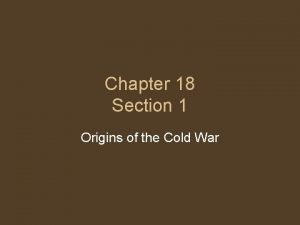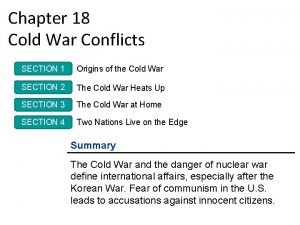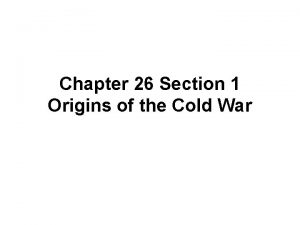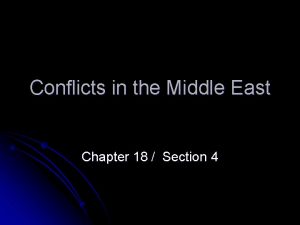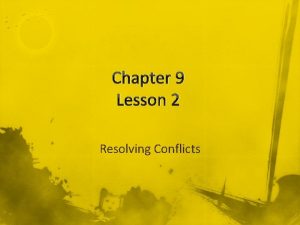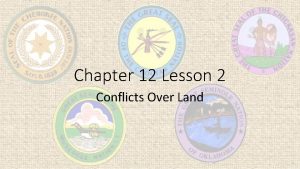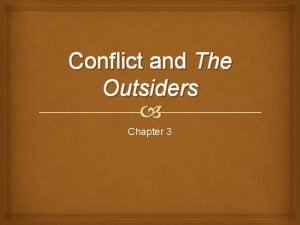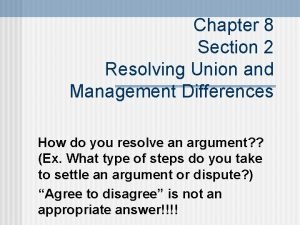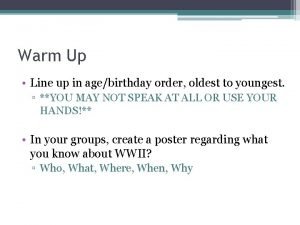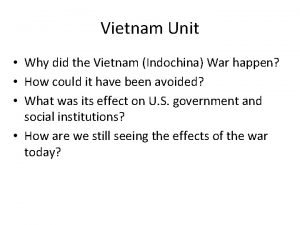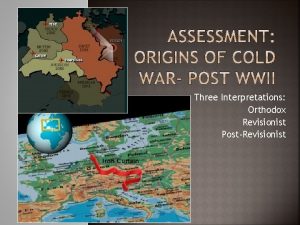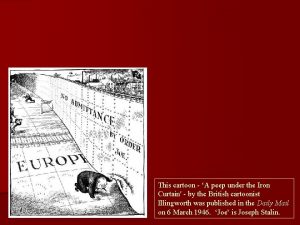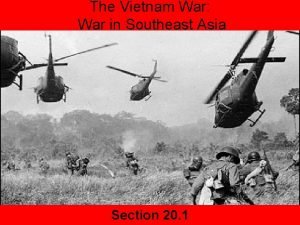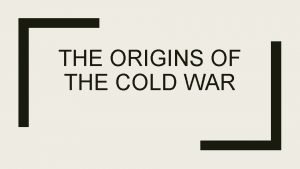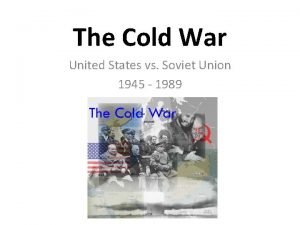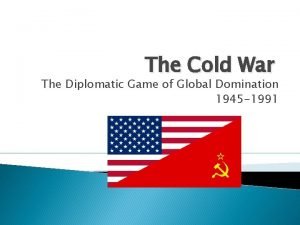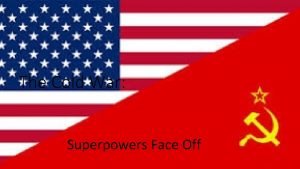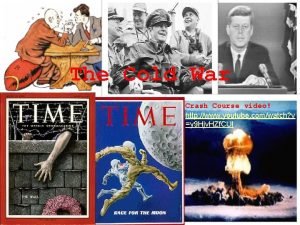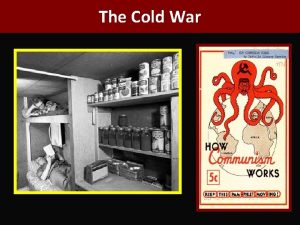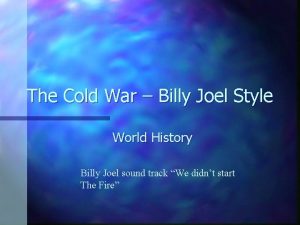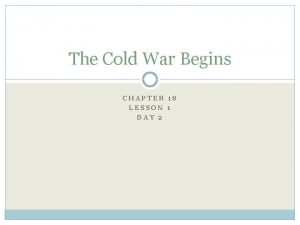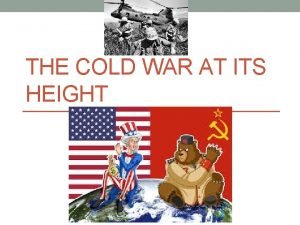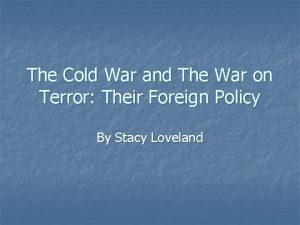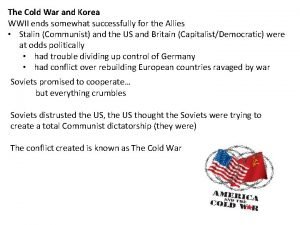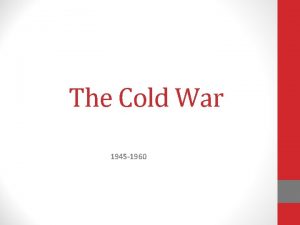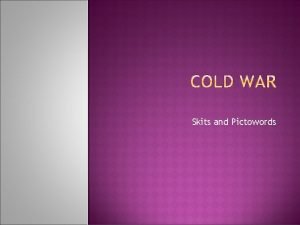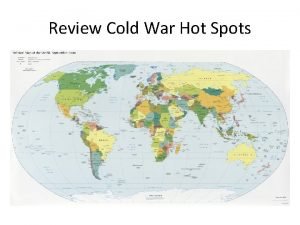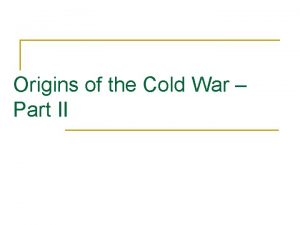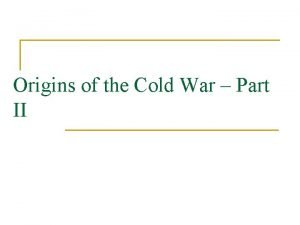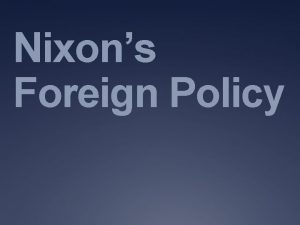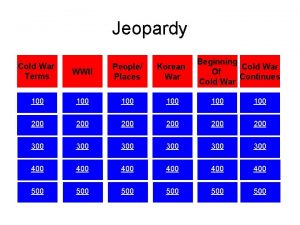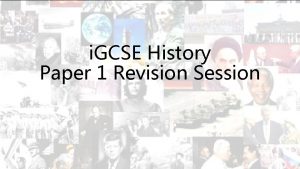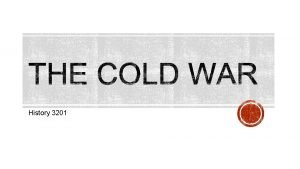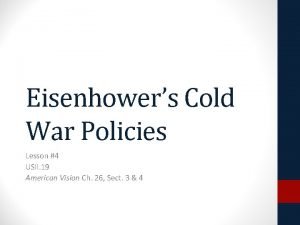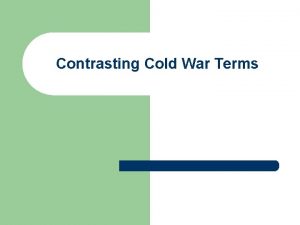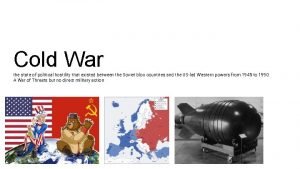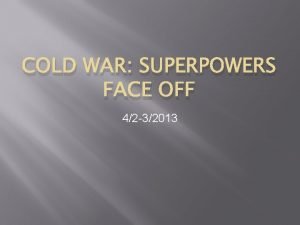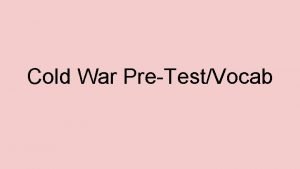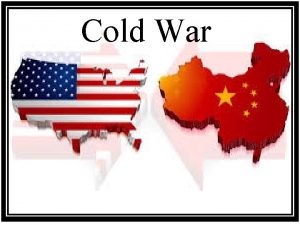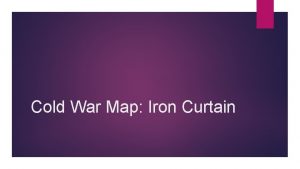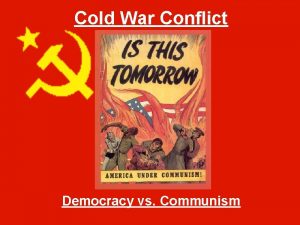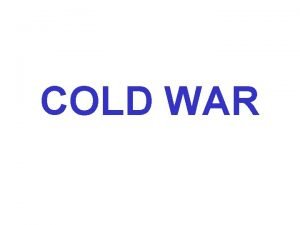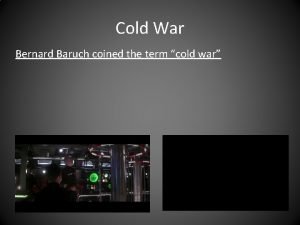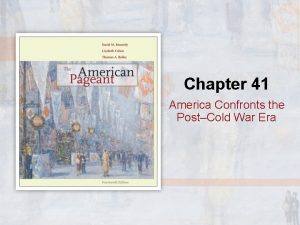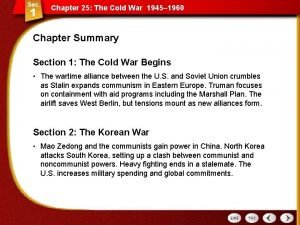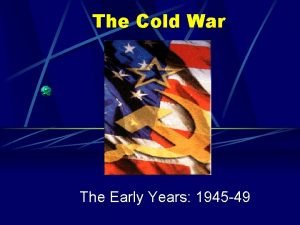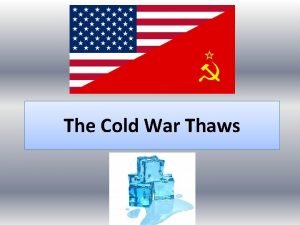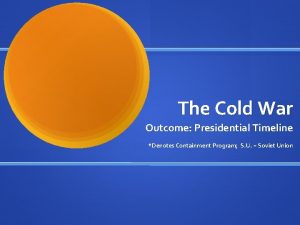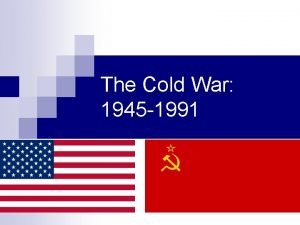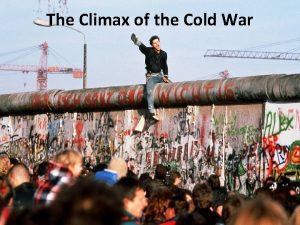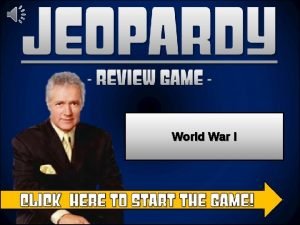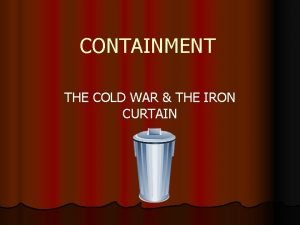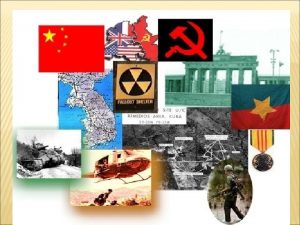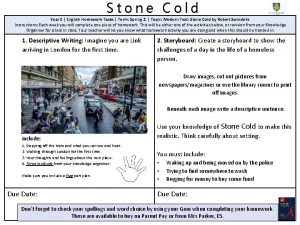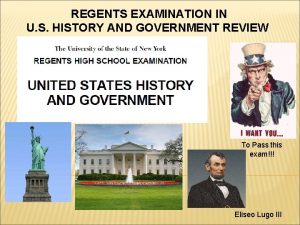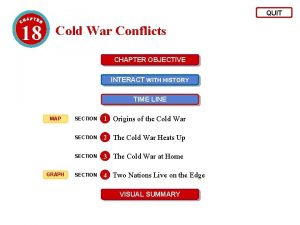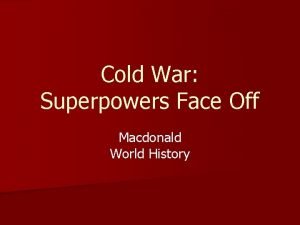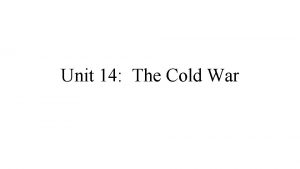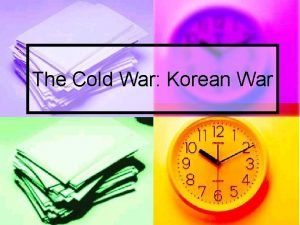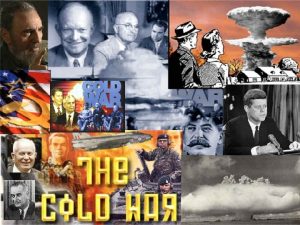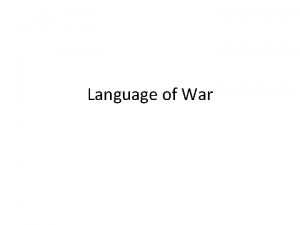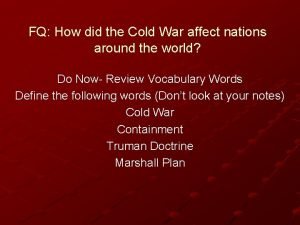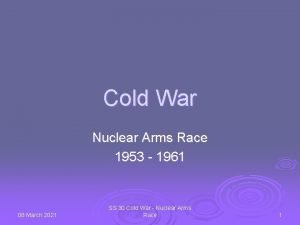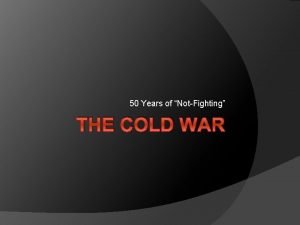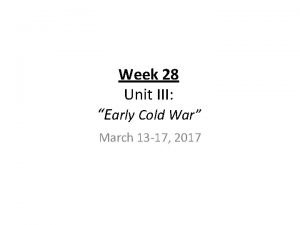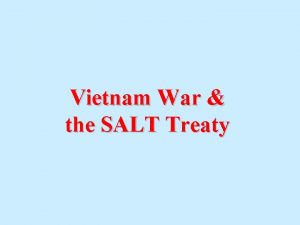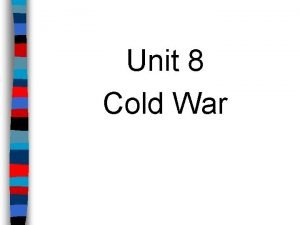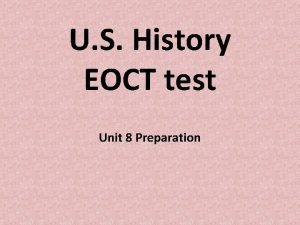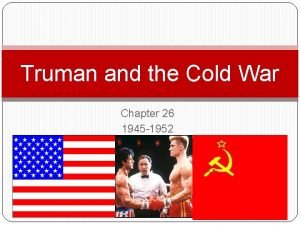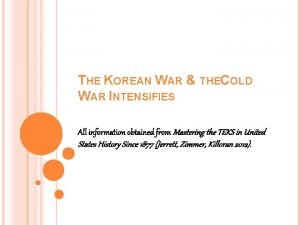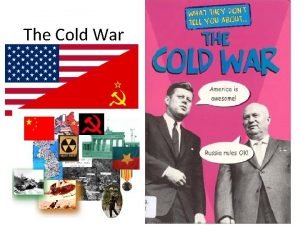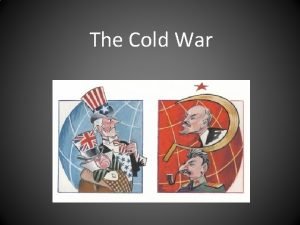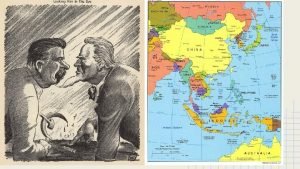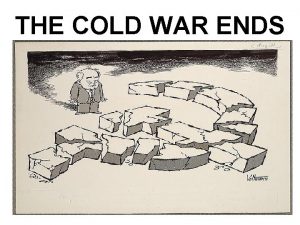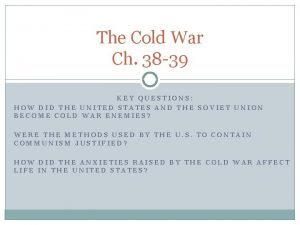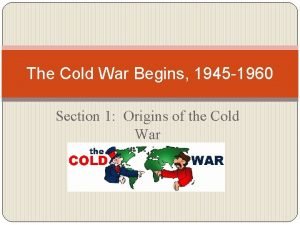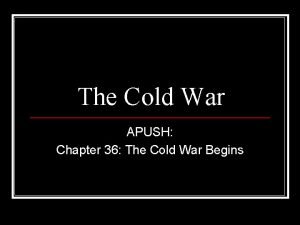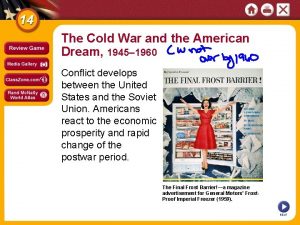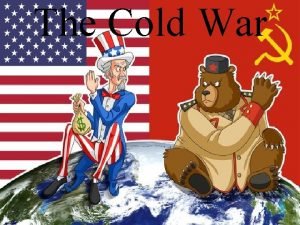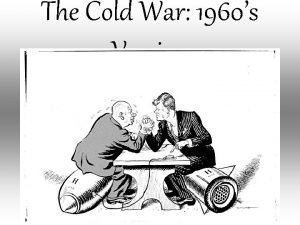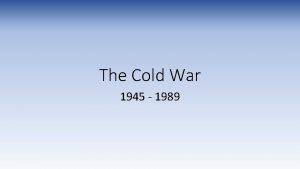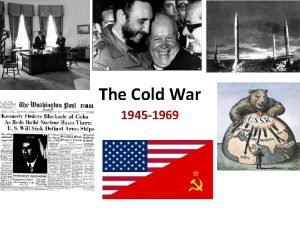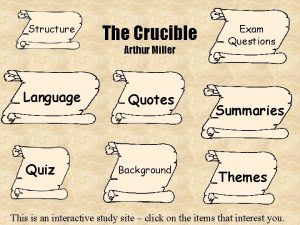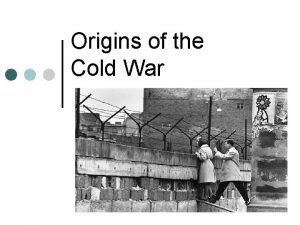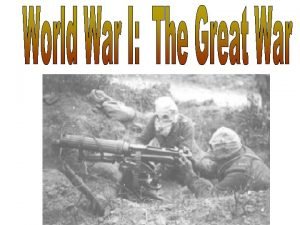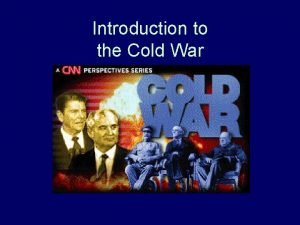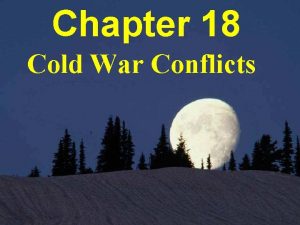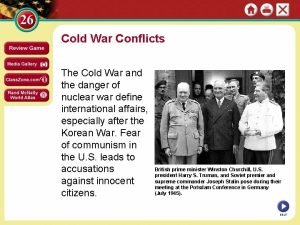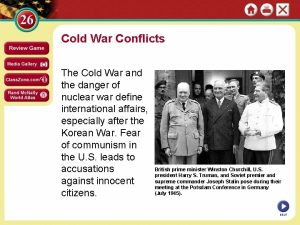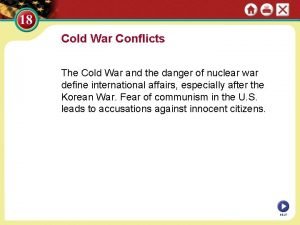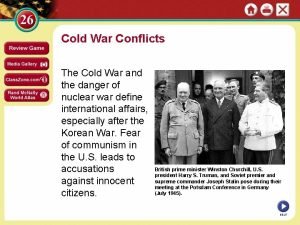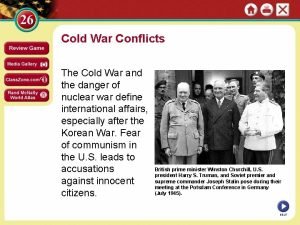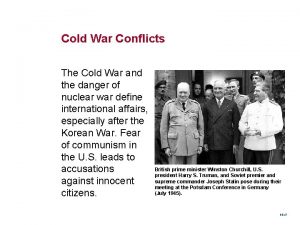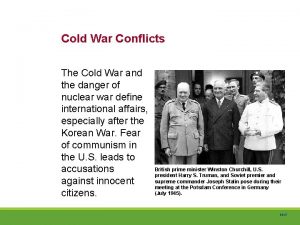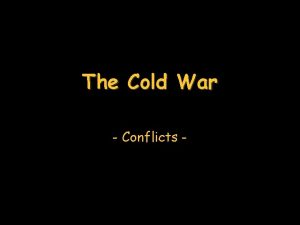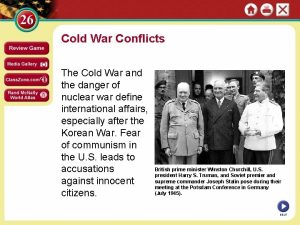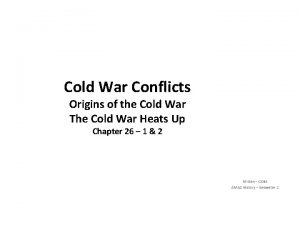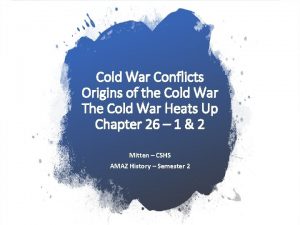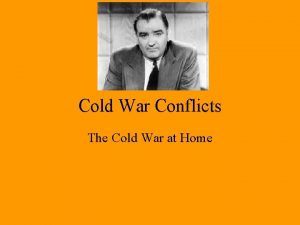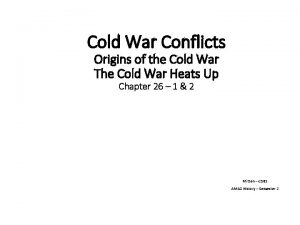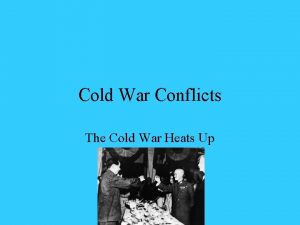Chapter 18 The Cold War Conflicts The Cold




















![The Ideological Struggle Soviet & Eastern Bloc Nations [“Iron Curtain”] GOAL spread world-wide Communism The Ideological Struggle Soviet & Eastern Bloc Nations [“Iron Curtain”] GOAL spread world-wide Communism](https://slidetodoc.com/presentation_image/35fefbe94e7a8b41e908fa3473702afa/image-21.jpg)





























![Korean War [1950 -1953] Korean War [1950 -1953]](https://slidetodoc.com/presentation_image/35fefbe94e7a8b41e908fa3473702afa/image-51.jpg)



![Korean War [1950 -1953] Kim Il-Sung Syngman Rhee “Domino Theory” Korean War [1950 -1953] Kim Il-Sung Syngman Rhee “Domino Theory”](https://slidetodoc.com/presentation_image/35fefbe94e7a8b41e908fa3473702afa/image-55.jpg)







![The Shifting Map of Korea [1950 -1953] The Shifting Map of Korea [1950 -1953]](https://slidetodoc.com/presentation_image/35fefbe94e7a8b41e908fa3473702afa/image-63.jpg)






















![National Defense Budget [1940 -1964] National Defense Budget [1940 -1964]](https://slidetodoc.com/presentation_image/35fefbe94e7a8b41e908fa3473702afa/image-86.jpg)
































- Slides: 118


Chapter 18 The Cold War Conflicts

The Cold War 19451991

The Cold War 1945 -1991 The Cold War and the danger of nuclear war define international affairs.

Section 1: Origins of the Cold War I. Postwar Europe A. The United States and the Soviet Union emerge from World War II as two “superpowers” with vastly different political and economic systems. The Cold War 1945 -1991 B. After the war, U. S. and Soviet political leaders wanted to make Europe stable in order to prevent a future world war. C. Each side wanted its worldview to be dominant (capitalism vs. communism).

II. Former Allies Clash A. U. S. -Soviet Relations 1. U. S. , U. S. S. R. have very different economic, political systems 2. U. S. vs. Capitalism Private property Democratic USSR (Soviet Union) Communism State owns Totalitarian 3. U. S. suspicious of Stalin because he had been Hitler’s ally 4. Stalin resents that U. S. delayed attacking Germany and hid atom bomb

B. The United Nations 1. 1945, United Nations established as new peacekeeping body 2. UN becomes arena where U. S. , U. S. S. R. compete

C. The Potsdam Conference • Harry S. Truman succeeds FDR as president • As vice-president, Truman was not included in policy decisions- was not told about atom bomb 1. July 1945 conference with U. S. , Great Britain, Soviet Union 2. Stalin does not allow free, multiparty elections in Poland - bans democratic parties. SOVIET BLOC

Soviet Bloc 3. SOVIET BLOC = Countries of Poland, Czechoslovakia, Hungary, Romania, Bulgaria, Yugoslavia and Albania were under Soviet control and had communist governments.

EASTERN BLOC

III. Tension Mounts A. Bargaining at Potsdam 1. Truman becomes convinced that U. S. , Soviet aims deeply at odds 2. Soviets want reparations from Germany; Truman objects 3. Agree to take reparations mainly from own occupation zones

Tension Mounts B. Soviets Tighten Their Grip on Eastern Europe 1. Installs communist rule in satellite nations, countries it dominates 2. 1946, Stalin announces war between communism, capitalism inevitable C. United States Establishes a Policy of Containment 1. U. S. policy of containment —measures to prevent spread of communism 2. Churchill describes division of Europe as iron curtain

Iron Curtain

The “Iron Curtain” From Stettin in the Balkans, to Trieste in the Adriatic, an iron curtain has descended across the Continent. Behind that line lies the ancient capitals of Central and Eastern Europe. -- Sir Winston Churchill, 1946





D. Cold War 1. a non-military battle of diplomacy and propaganda between the United States and Soviet Union 2. 1945– 1991 Cold War —conflict between U. S. , U. S. S. R. neither nation directly confronts the other on battlefield 3. led to “hot” wars around globe in Korea, Vietnam – Many of the smaller wars were called proxy wars because the U. S. and U. S. S. R. never fought face to face

![The Ideological Struggle Soviet Eastern Bloc Nations Iron Curtain GOAL spread worldwide Communism The Ideological Struggle Soviet & Eastern Bloc Nations [“Iron Curtain”] GOAL spread world-wide Communism](https://slidetodoc.com/presentation_image/35fefbe94e7a8b41e908fa3473702afa/image-21.jpg)
The Ideological Struggle Soviet & Eastern Bloc Nations [“Iron Curtain”] GOAL spread world-wide Communism METHODOLOGIES: « Espionage [KGB vs. CIA] US & the Western Democracies GOAL “Containment” of Communism & the eventual collapse of the Communist world. [George Kennan] « Arms Race [nuclear escalation] « Ideological Competition for the minds and hearts of Third World peoples [Communist govt. & command economy vs. democratic govt. & capitalist economy] “proxy wars” « Bi-Polarization of Europe [NATO vs. Warsaw Pact]

IV. Cold War in Europe FIGHTING COMMUNISM A. CONTAINMENT POLICY: The U. S. would work to stop the spread of communism. 1. Truman Doctrine 2. Marshall Plan 3. NATO and other alliances 4. Containment led to wars in Korea and Vietnam.

The Truman Doctrine B. Truman Doctrine —U. S. would aid countries around the world who are fighting communism (like Greece and Turkey). 1. It signaled the end of “isolationist” policies. 2. U. S. replaces British aid to Greece, Turkey; reduce communist threat C. The Marshall Plan 1. 1947, Sec. of State George Marshall proposes aid to nations in need 2. Marshall Plan revives 16 nations; Communist parties less appealing

The ‘Truman Doctrine’ • Truman had been horrified at the pre-war Allied policy of appeasement and was determined to stand up to any Soviet intimidation. The Truman Doctrine in March 1947 promised that the USA “would support free peoples who are resisting subjugation by armed minorities or by outside pressures”. • Triggered by British inability to hold the line in Greece, it was followed by aid to Greece and Turkey, and also money to help capitalists to stop communists in Italy and France. It signalled the end of “isolationist” policies.

The Truman Doctrine & Domino Theory Truman Doctrine: U. S. would aid countries around the world who are fighting communism (like Greece and Turkey). D Domino Theory: If the U. S. doesn’t fight communism, then countries will fall to communism like dominos.

The Marshall Plan 1948 • Plan to aid Europe— in ruins – Prevent countries from falling to communists – Aid American business • $17 billion to 16 countries in Europe (not Soviet Union)

The ‘Marshall Plan’ • The Marshall Plan offered huge sums to enable the economies of Europe to rebuild after World War II, and, by generating prosperity, to reject the appeal of Communism. The Soviet Union (USSR) prevented Eastern European countries from receiving American money.

V. Postwar Germany A. Divided into 4 zones: 1. West Germany – U. S. , Britain, and France 2. East Germany- Soviets 3. Capitol city of Berlin divided into 4 zones (in East Germany) B. Berlin Airlift: In 1948 -49, the U. S. and Europe flew food and supplies to save West Berlin, until Soviets reopened roads.

VI. Superpowers Struggle over Germany The Berlin Airlift A. Berlin Blockade- 1948, Stalin closes highway, rail routes into West Berlin 1. one of the first major international crises of the Cold War 2. Soviet Union blocked the Western Allies' railway, road, and canal access to the sectors of Berlin under allied control. 3. Berlin airlift —Britain, U. S. fly food, supplies into West Berlin 4. 1949, Neither side wanted a war; the Soviets did not disrupt the airlift, Stalin lifts blockade 5. Federal Republic of Germany, German Democratic Republic form B. Fear of Soviets leads to North Atlantic Treaty Organization (NATO) 1. European nations, U. S. , Canada pledge mutual military support


Improve your knowledge • The Russians took very high casualties to capture Berlin in May 1945. They spent the early occupation trying to take over all zones of the city but were stopped by German democrats such as Willy Brandt and Konrad Adenauer. Reluctantly the Russians had to admit the Americans, French and British to their respective zones.

Iron Curtain – A term used by Winston Churchill to describe the separating of Those communist lands of East Europe from the West.

Berlin Blockade & Airlift (1948 -49)

Berlin • West Berlin, was an outpost of Western democracy and economic success deep within the communist zone – like a capitalist island within communist East Germany • The Berlin Blockade was an attempt to starve West Berlin into submitting [giving up] to the communists • The Allied [western powers] airlift signalled the West’s determination to use all resources to defend Berlin. It was felt by both sides that Berlin could act as the trigger for general war between capitalist and communist countries

C. NATO vs. WARSAW PACT 1. North Atlantic Treaty Organization: defense alliance among U. S. and Europe against the Soviet Union. Still exists. 2. Warsaw Pact: Defense alliance among Soviet Union and its satellite governments in Eastern Europe.

North Atlantic Treaty Organization (1949) v United States v Luxemburg v Belgium v Netherlands v Britain v Norway v Canada v Portugal v Denmark v 1952: Greece & v France v Iceland v Italy Turkey v 1955: West Germany v 1983: Spain

Warsaw Pact (1955) U. S. S. R. } } Albania Bulgaria Czechoslovakia East Germany } Hungary } } } Poland Rumania

Post War Japan: A. U. S. occupied – under General Mac. Arthur 1. New constitution 2. Democracy with Emperor as figurehead 3. Rebuild economy 4. Abolished army and navy B. Tokyo trials convicted war criminals

Section 2: The Cold War Heats Up I. China Becomes a Communist Country A. Chinese Communists battle nationalist government of Chiang Kai-shek • U. S. supports Chiang, but his government is inefficient, corrupt B. Communists, led by Mao Zedong, work to get peasant support C. Peasants flock to Red Army; by 1945, communists control north China

Mao’s Revolution: 1949 Who lost China?

Renewed Civil War D. 1944– 47, U. S. sends military aid to Nationalists to oppose communism E. 1949, Nationalists flee to island of Taiwan F. Communists establish People’s Republic of China in mainland G. U. S. does not recognize Communist Chinese government America Reacts to Communist Takeover H. U. S. public stunned by Communist takeover I. Conservatives blame Truman for not sending enough aid

Growing Interest in China People’s Republic of China: • In the 1940’s, China was embroiled in a civil war. Nationalists Led by Chiang Kai-shek Communists Led by Mao Zedong

• The U. S. gave the Chiang Kai-shek millions of dollars, but the communists won the war.

• China became a communist country, and Chiang Kai-shek and his forces fled to Taiwan.

China and Russia sign a treaty of friendship and alliance

II. The Korean War 1950 -53 A. First place where the collision between communism and capitalism led to war. B. 38 th parallel (38º N latitude) divides Japanese surrender in Korea 1. North Korea- Area north of the 38 th Parallel that became communist under Russian guidance. 2. South Korea -Area south of the 38 th Parallel that became democratic with support from the U. S. C. North of 38 th parallel surrenders to U. S. S. R. ; south to U. S. 1. Republic of Korea, Democratic People’s Republic of Korea founded D. 1950, North Korea (communist) invades South, begins Korean War E. South Korea calls on UN to stop invasion; Security Council approves F. Macarthur put in command of South Korean, U. S. , other forces

Where is Korea?

North Korea • Area north of the 38 th Parallel that became communist under Russian guidance.

Where is Korea? 38 th Parallel

South Korea • Area south of the 38 th Parallel that became democratic with support from the U. S.
![Korean War 1950 1953 Korean War [1950 -1953]](https://slidetodoc.com/presentation_image/35fefbe94e7a8b41e908fa3473702afa/image-51.jpg)
Korean War [1950 -1953]

Mac. Arthur’s Counterattack G. North Korea drives south, captures Seoul H. UN (multi-national), South Korean troops forced into small defensive zone I. Mac. Arthur attacks North Koreans from 2 sides, pushes into north almost to Chinese border • The Chinese Fight Back J. China sends troops to help North Korea; push south, capture Seoul • Fighting continues for 2 more years K. limited war = war fought to achieve a specific objective.

Douglas Mc. Arthur • US World War II general who led the UN forces in Korea. • Mc. Arthur pushed the North Koreans back almost to the Chinese border.

Mac. Arthur at Inch'on landing • U. S. General Douglas Mac. Arthur led the U. N. force, approximately 80% of which were U. S. soldiers.
![Korean War 1950 1953 Kim IlSung Syngman Rhee Domino Theory Korean War [1950 -1953] Kim Il-Sung Syngman Rhee “Domino Theory”](https://slidetodoc.com/presentation_image/35fefbe94e7a8b41e908fa3473702afa/image-55.jpg)
Korean War [1950 -1953] Kim Il-Sung Syngman Rhee “Domino Theory”

Kim Jong-il 1994 -2011& Kim Jong Un 2011 - Present

Mac. Arthur Recommends Attacking China L. Mac. Arthur calls for war with China; Truman rejects request M. Soviet Union, China have mutual assistance pact N. UN, South Korea retake Seoul, advance north to 38 th parallel O. Mac. Arthur continues to push for invasion of China; Truman fires him • Public outraged over hero’s dismissal • Congressional committee investigation concludes Truman right

Harry S Truman

Ending the War: • U. N. troops regained South Korea by March of 1951. • Gen. Mac. Arthur wanted to attack China with support of Chinese nationalists. • President Truman disagreed with Mac. Arthur about attacking China.

• Truman fired Mac. Arthur for defying him by publicly taunting and threatening the Chinese.

Settling for Stalemate P. 1951, Soviet Union suggests cease-fire Q. 1953 armistice: Korea still divided; demilitarized zone established R. Lack of success, high human, financial costs help elect Eisenhower

Korean War Recap, 1950 -53 1. Divided north and south at 38 th parallel at end of WWII. 2. In 1950, Communist North Korea invaded South Korea. 3. The U. S. and United Nations, aided the South; China aided the North Koreans. 4. Treaty signed in 1953, keeping dividing line at 38 th parallel (still today). 5. 33, 000 American soldiers died, 100, 000 wounded.
![The Shifting Map of Korea 1950 1953 The Shifting Map of Korea [1950 -1953]](https://slidetodoc.com/presentation_image/35fefbe94e7a8b41e908fa3473702afa/image-63.jpg)
The Shifting Map of Korea [1950 -1953]

• In July of 1953, the Korean War ended

Section 3: The Cold War at Home I. Fear of Communist Influence A. Communist takeover of Eastern Europe, China fuel fear of its spread B. 100, 000 in U. S. Communist Party; some fear may be loyal to U. S. S. R. C. Loyalty Review Board 1. Truman accused of being soft on Communism 2. Sets up Federal Employee Loyalty Program to investigate employees 3. 1947– 1951 loyalty boards investigate 3. 2 million, dismiss 212

C. The Red Scare 1. Intense fear of Communists taking over U. S. – China became a Communist country in 1949. – Soviets developed an atomic bomb in 1949. – Rosenberg's convicted of selling atomic secrets to Soviet Union. Executed 1953.

The Arms Race: A “Missile Gap? ” } The Soviet Union exploded its first A-bomb in 1949. } Now there were two nuclear superpowers!

Improve your knowledge • The nuclear bomb gave America a lead which was expected to last at least 5 years. The rapid Russian development of nuclear technology, helped by the work of the “atom spies” was a shock. Significantly, Russia hurriedly declared war against Japan at the beginning of August 1945 and rushed to advance into Asia to stake out a position for the postwar settlement. This helped make both the Korean and Vietnamese conflicts more likely.

D. The House Un-American Activities Committee 1. investigates Communist ties 2. Investigates Communist influence in movie industry 3. Hollywood Ten refuse to testify, sent to prison -The 10 were Alvah Bessie, Herbert Biberman, Lester Cole, Edward Dmytryk, Ring Lardner, Jr. , John Howard Lawson, Albert Maltz, Samuel Ornitz, Adrian Scott, and Dalton Trumbo. 4. Hollywood blacklist —people with Communist ties, cannot get work E. The Mc. Carran Act 1. Act—unlawful to plan action that might lead to totalitarianism 2. Truman vetoes, says violates free thought; Congress overrides veto

II. Spy Cases Stun the Nation A. Alger Hiss accused of spying for Soviet Union; convicted of perjury 1. Congressman Richard Nixon gains fame for pursuing charges B. The Rosenberg's 1. 1949, Soviets explode atomic bomb sooner than expected 2. Physicist Klaus Fuchs admits giving information about U. S. bomb 3. Ethel, Julius Rosenberg, minor Communist Party activists, implicated 4. Rosenberg's sentenced to death; Supreme Court upholds conviction

C. J. Edger Hoover- Director of the FBI who led the investigation.

J. Edgar Hoover

III. Mc. Carthy Launches His “Witch Hunt” A. Senator Joseph Mc. Carthy a strong anti-Communist activist • Ineffective legislator; needs issue to win reelection 1. Mc. Carthyism—attacking suspected Communists without evidence B. Mc. Carthy claims Communists in State Department

Mc. Carthy’s Downfall C. 1954, Mc. Carthy accuses members of U. S. Army D. Televised hearings show him bullying witnesses E. Loses public support; Senate censured (punished) him for improper conduct

F. Mc. Carthyism 1. In 1950, Republican Senator Joseph Mc. Carthy of Wisconsin claimed that he had “lists” of communists in the U. S. government. 2. Falsely accused hundreds of people of being active Communists, ruining lives. 3. When hearings were televised, people saw that Mc. Carthy was wrongly accusing many people. 4. Censured (punished) by Senate.


Section 4: Two Nations Live on the Edge I. Brinkmanship Rules U. S. Policy A. Dwight “Ike” Eisenhower elected president in 1952. 1. Former WWII general. 2. Disagreed with Truman’s strategy. 3. Vice President Dulles – staunch anti-communist – proposed Brinkmanship a. threaten use nuclear weapons if a crisis developed. B. Race for the H-Bomb 1. H-bomb—hydrogen bomb—nuclear weapon more powerful than atom bomb 2. 1952, U. S. explodes first H-bomb; 1953, Soviets explode one

Dwight D. Eisenhower As President During the War

U. S tests the H-bomb • U. S. successfully tested the Hydrogen bomb that was 450 times more powerful than the bomb dropped on Nagasaki.

“I like Ike”

C. The Policy of Brinkmanship 1. John Foster Dulles, secretary of state under Dwight D. Eisenhower proposes brinkmanship policy: - willingness to risk nuclear war to prevent spread of communism 2. Nuclear threat unlike any before: millions can die; nation prepares


D. Central Intelligence Agency (CIA) 1. Government agency that conducted covert missions to prevent other nations from falling to communism. 2. CIA conducted missions in Egypt, Iran, Guatemala, Hungary. (Middle East & Latin America)


E. Nuclear Arms Race was a competition for supremacy in nuclear warfare between the United States and the Soviet Union 1. Tested nuclear technology and stockpiled weapons • Hydrogen bomb invented – both U. S. and Soviets had them • more powerful than atomic bomb—vaporized an island. • Dangers of fallout and radiation 2. Many built bomb shelters or fail out shelters=Underground shelters to protect people from radiation after an atomic blast.
![National Defense Budget 1940 1964 National Defense Budget [1940 -1964]](https://slidetodoc.com/presentation_image/35fefbe94e7a8b41e908fa3473702afa/image-86.jpg)
National Defense Budget [1940 -1964]

II. The Cold War Spreads Around the World A. Covert Actions in the Middle East and Latin America 1. Central Intelligence Agency (CIA) uses spies to gather information 2. CIA helps oust Iranian prime minister, reinstate Shah 3. CIA helps depose Guatemala’s president; army leader becomes dictator B. The Warsaw Pact 1. U. S. -Soviet relations thaw after Stalin’s death in 1953 2. West Germany’s entry into NATO scares Soviets 3. Form Warsaw Pact —military alliance with 7 Eastern European countries=1955

C. A Summit in Geneva 1. Eisenhower meets Soviets in Geneva, proposes “open skies” policy 2. Soviets reject proposal; “spirit of Geneva” seen as step to peace D. The Suez War 1. Nasser nationalizes Suez Canal; USSR supports 2. Israel, Britain, France send troops; UN intervenes 3. Fighting stops; Egypt keeps canal; others withdraw

The Eisenhower Doctrine E. The Eisenhower Doctrine 1. Soviet prestige in Middle East rises because of support for Egypt 2. Eisenhower Doctrine—U. S. will defend Middle East against communists F. The Hungarian Uprising 1. 1956, Hungarians revolt, call for democratic government 2. Imre Nagy, Communist leader, forms government, promises elections 3. Soviet army does not allow elections; overthrow Nagy 4. U. S. does not help Soviet satellite; Soviets veto action by UN

III. The Cold War Takes to the Skies A. Nikita Khrushchev favors: peaceful coexistence and economic, scientific competition; ruled USSR 1958 -1964 B. The Space Race • October 1957, Soviets launch Sputnik, • first satellite Shocked Americans pour money into own space program

Premier Nikita Khrushchev About the capitalist states, it doesn't depend on you whether we (Soviet Union) exist. If you don't like us, don't accept our invitations, and don't De-Stalinization invite us to come Program to see you. Whether you like it our not, history is on our side. We will bury you. -- 1956

An Historic Irony: Sergei Khrushchev, American Citizen Who buried who?

Space Race 1. Began when Soviets beat the U. S. into space a) Soviet 1 st man made satellite, or artificial, Sputnik launched in 1957 b) Explorer I, the first U. S. satellite, was launched in 1958. 2. The National Defense Act of 1958 approved federal funding of education in math, science and foreign languages. Reforms in education 3. NASA 1958

C. A U-2 Is Shot Down 1. CIA makes secret high-altitude flights with U-2 to spy on Soviets 2. Eisenhower wants flights discontinued before Khrushchev summit 3. Francis Gary Powers shot down on last flight over Soviet territory-1960 Renewed Confrontation 4. Eisenhower first denies, then concedes U-2 was spying 5. Agrees to stop flights, refuses to apologize as Khrushchev demands 6. U-2 incident renews tension between superpowers; summit cancelled

U-2 Spy Incident (1960) Col. Francis Gary Powers’ plane was shot down over Soviet airspace.

Nixon-Khrushchev “Kitchen Debate” (1959) Cold War ---> Tensions <--- Technology & Affluence

Paris, 1961 Khrushchev & JFK meet to discuss Berlin and nuclear proliferation. Khrushchev thinks that JFK is young, inexperienced, and can be rolled.

The Berlin Wall Goes Up (1961) Checkpoint Charlie

• http: //www. history. com/topics/cold -war/berlin-airlift/videos

Ich bin ein Berliner! (1963) President Kennedy tells Berliners that the West is with them!

Khruschev Embraces Castro, 1961

Bay of Pigs Debacle (1961)

Cuban Missile Crisis (1962)

Cuban Missile Crisis (1962) We went eyeball-to-eyeball with the Russians, and the other man blinked!

Cuban Missile Crisis (1962)

Vietnam War: 1965 -1973

The Cold War Years Quiz

Who controlled East Berlin? A. B. C. D. United States Soviet Union Cuba England

How did America get supplies to West Berlin? A. B. C. D. Mailed them U. P. S. Sent them in by trains. Flew them in by planes. Dropped them from a parachute.

Who invaded South Korea and tried to take over their country? A. B. C. D. Britain North Korea United States USSR

Who was president during the Cuban Missile Crisis? A. B. C. D. Lyndon B. Johnson Thomas Jefferson John F. Kennedy Ronald Reagan

Where did the Soviet Union build their missile sites? A. B. C. D. Russia England United States Cuba

How did the United States avoid nuclear with the Soviets? A. Set up a naval blockade around Cuba. B. Threatened to bomb Russia. C. Told Soviet leaders to take a hike. D. Attacked Russia’s military.

What was the arms race? A. It was the way presidents are elected. B. It was the build up of weapons in order to have the most power for protection. C. It was the invention of the atomic bomb. D. It was the way many Americans

GET YOUR STR QUESTIONS OUT! 140. What was the struggle for world control between the US and Soviets after WWII? Cold War 141. During what years was this aggression the most intense? 1945 -1963 142. Who were three presidents during this period of aggression? Truman, Eisenhower, Kennedy 143. During what decade does this aggression finally end? 1990’s

144. What was the union between the Soviet Union and its satellite nations called? Warsaw Pact 145. What did Winston Churchill call the imaginary line between communist and non-communist Europe? Iron Curtain 146. What plan gave money to rebuild Europe after WWII? Marshall Plan 147. What government plan gave money to Greece and Turkey to help them fight off communist nations? Truman Doctrine 148. What was the US’ defensive military alliance after WWII called? North Atlantic Treaty Organization

149. What war was fought over countries divided at the 38 th Parallel? Korea 150. Which part of Korea was Communist? North Korea 151. Who was the outcome of the Korean War? No one, it was a stalemate 152. What type of government did China get after WWII? Communist 153. Who became infamous for accusing others of being Communists in the US? Senator Joseph Mc. Carthy

154. What US couple was killed for giving bomb secrets to the Soviets? Ethel and Julius Rosenberg 155. What was the first man-made satellite to orbit the earth? Sputnik 156. What type of spy plane was shot down over the Soviet Union? U-2 157. What was Eisenhower’s foreign policy that was willing to go to the edge of war? Brinkmanship
 The cold war lesson 1
The cold war lesson 1 Proxy wars in the cold war
Proxy wars in the cold war Chapter 30 the war to end war
Chapter 30 the war to end war Chapter 30 the war to end war
Chapter 30 the war to end war Chapter 33 section 4 foreign policy after the cold war
Chapter 33 section 4 foreign policy after the cold war Chapter 17 section 1 cold war two superpowers face off
Chapter 17 section 1 cold war two superpowers face off Chapter 40 fighting the cold war at home
Chapter 40 fighting the cold war at home Chapter 28 section 1 kennedy and the cold war
Chapter 28 section 1 kennedy and the cold war Chapter 26 section 2 the cold war heats up answer key
Chapter 26 section 2 the cold war heats up answer key Chapter 20 section 1 kennedy and the cold war
Chapter 20 section 1 kennedy and the cold war The cold war heats up chapter 18 section 2
The cold war heats up chapter 18 section 2 Chapter 25 cold war america
Chapter 25 cold war america Chapter 18 section 1 origins of the cold war
Chapter 18 section 1 origins of the cold war Origins of the cold war chapter 18 section 1
Origins of the cold war chapter 18 section 1 Chapter 26 section 1 origins of the cold war
Chapter 26 section 1 origins of the cold war Chapter 18 section 4 conflicts in the middle east
Chapter 18 section 4 conflicts in the middle east Chapter 9 lesson 2 resolving conflicts
Chapter 9 lesson 2 resolving conflicts Chapter 9 lesson 2 resolving conflicts
Chapter 9 lesson 2 resolving conflicts Chapter 12 lesson 2 conflicts over land
Chapter 12 lesson 2 conflicts over land Chapter 9 resolving conflicts and preventing violence
Chapter 9 resolving conflicts and preventing violence Resolution of the outsiders
Resolution of the outsiders Modified union shop definition
Modified union shop definition War at home and abroad madison
War at home and abroad madison Description
Description Presidential and congressional reconstruction venn diagram
Presidential and congressional reconstruction venn diagram Why was josette dugas for the war of 1812
Why was josette dugas for the war of 1812 War warst war
War warst war Study jams force and motion
Study jams force and motion Why was the civil war the first modern war
Why was the civil war the first modern war Simple past bringen
Simple past bringen Chapter 16 lesson 2 challenges to slavery
Chapter 16 lesson 2 challenges to slavery The cold war acrostic poem
The cold war acrostic poem Operation rolling thunder cold war
Operation rolling thunder cold war Cold war
Cold war Iron curtain cartoons
Iron curtain cartoons Operation rolling thunder cold war
Operation rolling thunder cold war Causes of the cold war
Causes of the cold war The cold war thaws worksheet answers
The cold war thaws worksheet answers Effects of cold war
Effects of cold war Superpowers cold war
Superpowers cold war Cold war crash course
Cold war crash course Characteristic of the cold war
Characteristic of the cold war Mafia hula hoops 1959
Mafia hula hoops 1959 Lesson quiz 18-1 the cold war
Lesson quiz 18-1 the cold war Cold war height
Cold war height Who was involved in the cold war
Who was involved in the cold war Non aligned countries during cold war
Non aligned countries during cold war Cold war two sides
Cold war two sides Korean war summary
Korean war summary Democracy pictoword
Democracy pictoword Cold war hot spots
Cold war hot spots Origins of the cold war
Origins of the cold war Origins of the cold war
Origins of the cold war Vietnamization definition
Vietnamization definition Why did stalin want to create a “buffer zone”?
Why did stalin want to create a “buffer zone”? Operation rolling thunder cold war
Operation rolling thunder cold war The cold war
The cold war Lesson 4 eisenhowers cold war policies
Lesson 4 eisenhowers cold war policies Contrasting cold war terms
Contrasting cold war terms Satellite states cold war
Satellite states cold war Cold war superpowers face off guided reading
Cold war superpowers face off guided reading Pretest communism and the cold war
Pretest communism and the cold war Communist and capitalist countries cold war
Communist and capitalist countries cold war Cold war iron curtain map
Cold war iron curtain map Cold war democracy vs communism
Cold war democracy vs communism Greater berlin
Greater berlin Tactic used to overcome a soviet blockade
Tactic used to overcome a soviet blockade America confronts the post-cold war era
America confronts the post-cold war era Cold war summary
Cold war summary The iron curtain
The iron curtain Marshall plan cold war
Marshall plan cold war Soviet union acrostic poem
Soviet union acrostic poem Cold war presidential timeline
Cold war presidential timeline Truman speech
Truman speech The cold war map
The cold war map Cold war vocabulary
Cold war vocabulary Climax of the cold war
Climax of the cold war Cold war map activity
Cold war map activity World war 1 jeopardy questions
World war 1 jeopardy questions Iron curtain containment
Iron curtain containment Marshall plan cold war definition
Marshall plan cold war definition Cold war us china
Cold war us china Communism cold war
Communism cold war Stone cold war
Stone cold war Watergate cold war
Watergate cold war Cold war tension graph
Cold war tension graph History of cold war
History of cold war The cold war vocabulary
The cold war vocabulary Rollback korean war
Rollback korean war Spain cold war
Spain cold war Comunist map
Comunist map Cold war epithet
Cold war epithet Cold war knowledge organiser
Cold war knowledge organiser Cold war
Cold war Cold war
Cold war Tosconini
Tosconini Inner party 1984
Inner party 1984 United nations flag
United nations flag What does salt stand for cold war
What does salt stand for cold war Unit 8: summarizing the cold war
Unit 8: summarizing the cold war Cold war
Cold war Characteristics of cold war
Characteristics of cold war The cold war intensifies
The cold war intensifies Iron curtain cold war
Iron curtain cold war Characteristics of cold war
Characteristics of cold war The cold war vocab
The cold war vocab Cold war
Cold war Europe after world war 2 map
Europe after world war 2 map The cold war begins 1945-1960
The cold war begins 1945-1960 Apush chapter 36 notes
Apush chapter 36 notes American dream cold war
American dream cold war Cold war
Cold war Cold war
Cold war Cold war mikhail gorbachev
Cold war mikhail gorbachev The cold war heats up: 1945 - 1969
The cold war heats up: 1945 - 1969 Themes in the crucible
Themes in the crucible The cold war
The cold war Mania acronym for causes of wwi
Mania acronym for causes of wwi Conclusion of foreign policy
Conclusion of foreign policy




